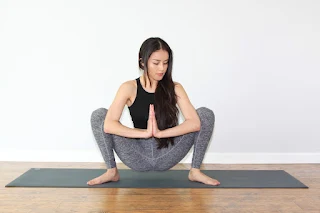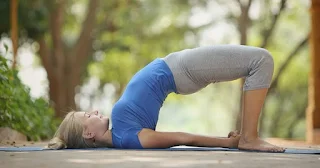Yoga for PCOS as a treatment symptoms? yes, Definitely. Yoga Clubs nowadays helping with Yoga poses. According to the Centers for Disease Control and Prevention, polycystic ovarian syndrome (PCOS) affects 6 to 12 percent of women during their reproductive years.
This common female endocrine condition produces an overproduction of male hormones in the ovaries, leading in irregular periods, weight gain, and fertility and ovulation issues. However, new evidence suggests that practising yoga on a regular basis can help manage PCOS symptoms. Yoga will not cure PCOS, but it can assist with some of the symptoms.
How yoga can help with PCOS symptoms?!
Yoga has been shown to lower testosterone levels.
According to a recent study, practising yoga can assist women with PCOS lower testosterone levels and reduce anxiety and depression symptoms. Participants who completed a one-hour yoga class three times a week for three months saw a 29 percent reduction in testosterone levels.
Researchers randomly allocated 31 women with PCOS between the ages of 23 and 42 to either a mindful yoga group or a control group in the trial. For three months, classes were held three times a week for one hour each. Endocrine, cardiometabolic, and psychological parameters were taken at the start of the study and again three months later.
Researchers discovered that women who completed the yoga intervention (13 in total) had lower free testosterone levels (5.96 vs. 4.24 pg/mL; P0.05) after the testing period. Free testosterone is a normal hormone that, in women with PCOS, can be elevated above normal female levels. Anxiety and depression symptoms improved for study participants as well.
Yoga is suitable for people of all fitness levels.
Although any moderate aerobic exercise can lead to improvements in PCOS symptoms and anxiety levels, yoga is suitable for people of all fitness levels and ages. Other forms of exercise, such as swimming, cycling, walking, or running, are not always as effective. Yoga also includes a mindfulness component that aids in relaxation and mood regulation.
Is there any particular yoga pose that can help?
Yoga can be practised in a variety of ways. This ancient practise has something for everyone, from a gentle flow to advanced poses reserved for experienced yogis. However, some styles may be better suited to relieving PCOS symptoms.
I recommend the more gentle yoga poses, especially those that focus on stretching and relaxation, for relief from the pain and other symptoms of PCOS.
Malasana
Malasana opens the hips while strengthening the pelvic floor and abdominal core. This can help people with PCOS by improving circulation and blood flow in the pelvic region, as well as improving metabolism and digestion. You can support yourself with a block or two under your glutes until your body gets used to this position.When you get into the position, it's fine if your heels don't stay planted on the ground. To keep you balanced and upright, use a rolled blanket to support your heels.
 |
| Malasana |
- Begin with your feet spaced about a mat's width apart.
- To get into a squat position, bend your knees and lower your buttocks toward the floor.
- Make a prayer position with your hands (anjali mudra). Allow your thumbs to rest on your sternum to keep your chest lifted.
- Stay engaged with your spine straight by pressing your upper arms/triceps inside your knees (elbows press into knees to open the hips).
- Draw the shoulder blades together and extend the low back.
- Hold this position for at least 5 breaths.
- Straighten your legs to get out of it.
- Three times in total, repeat the pose.
Setu Bandhasana
Commonaly Known as Bridge pose, Bridge Pose can help to relax the mind and relieve stress and anxiety while also relaxing the back muscles.
 |
| Setu Bandhasana |
- Begin by lying on your back on the floor with your knees folded and your feet hip-distance apart.
- Place your hands beside your body, palms down.
- Slowly lift your lower back, mid-back, and upper back off the floor while inhaling (while the pelvis lifts up, lengthen from pelvis to sternum).
- Roll the shoulders back and bring the chest closer to the chin.
- Maintain a straight line between your thighs and the floor, with all four corners of your feet firmly planted on the ground.
- Stay in this pose for 1–2 minutes, breathing easily.
- Rep up to 5 times more.
Dhanurasana
Widely known as Bow pose, dhanurasana can help relieve menstrual discomfort, stimulate reproductive organs, and regulate menstrual flow. “It improves circulation in the pelvic region, relieves tension in the abdominal organs, and stretches the muscles in the neck, shoulders, and legs,” she explains. Overall, it has the potential to reduce anxiety and stress.
 |
| Dhanurasana |
- Begin by lying down on your stomach with your arms by your sides.
- Fold your knees and reach for your ankles with your hands.
- Inhale deeply and lift your chest off the ground, pulling your legs up with you.
- Remember to breathe and hold the pose for 15 seconds.
- Bring your chest and legs back to the ground, let go of the hold on your ankles, and relax face down to release.
- Repeat the process three times more.
- If you can't reach both ankles at once, do one leg at a time or use a yoga strap for support.
Chakravakasana
Cat and cow pose, is must to do in list for PCOS.
Place your palms down, wrists and elbows under shoulders, knees under hips, and ankles straight back from the knees in a tabletop position. As the flow moves you, you can curl your toes under or lower the tops of your feet.
- Inhale, bend your elbows, lower your belly, lift your chin and tailbone at the same time, moving each vertebra of the spinal column in a wave.
- On the exhale, reverse the movement by tucking the tailbone and chin, doming the back, and drawing the navel toward the spine as the chin tips toward the chest.
- Rep for the desired number of times.
 |
| Chakravakasana |
Janusirsana
Janu Sirsasana (Head-of-the-Knee Pose) calms the mind and can help relieve depression, anxiety, and fatigue. It combines a forward fold, twist, and side body stretch all in one. Lengthen your spine and bend from your hip crease instead of rounding your back. Close your eyes and cultivate a sense of inner peace as you fold forward.
 |
| Janusirsana |
- Take a seat on a yoga mat.
- Extend your left leg to the corner of your mat, toes to the sky, foot flexed, back of the heel down. The right knee is bent, and the foot is tucked as close to the groyne as possible.
- Extend your arms over your legs, inhale deeply, and exhale slowly, moving your upper body toward your left foot and your right arm in an arc over your head. To add resistance and go deeper into this stretch of the rib cage facing the sky, use a strap (the right on this side).
- With each deep breath, notice the torso twist, shoulder/hip opener, gentle massage of the sacroiliac joint, and movement of the kidneys, ovaries, and each internal organ.
- Do 7–12 times.
Supta Baddhakonasana
Baddha Konasana, also known as Bound Angle Pose, Butterfly Pose, or Cobbler's Pose, and historically known as Bhadrasana, Throne Pose, is a seated asana in hatha yoga and modern yoga. It can be used as a meditation seat if the knees are resting on the floor. If you have a groyne or knee injury, you should avoid this asana. If you have high blood pressure or any other cardiac problems, be cautious when bending.
 |
| Supta Baddhakonasana |
- Begin by sitting on the mat with your legs stretched out in front of you.
- To press the soles together, bend your knees and bring your heels toward you. The sides of your knees will drop.
- Lean back until your back is flat on the ground. Arms will be open and supported, palms up.
- Close your eyes and take a few deep breaths for 3–5 minutes, or as long as you feel comfortable.
- Make sure to exit the pose mindfully, either by rolling to your right side and pausing there for several breaths before rising to seated, or in any other way that feels right to you.
Kapalbhati Pranayama
"Kapalbhati is a rapid breathing exercise that may help with weight management, blood sugar levels, and stress levels," according to the researchers. It's worth noting that Kapalabhati can help with various aspects, but its effectiveness against PCOS has yet to be proven. However, since both syndromes are caused by hyperinsulinemia, which is primarily caused by stress in today's world, Kapalabhati is thought to be effective against PCOS as well.
 |
| Kapalbhati Pranayama |
- Sit cross-legged on the floor or in a chair.
- Try to relax your entire body by closing your eyes.
- Deeply inhale through your nose while expanding your chest.
- To relax, exhale with firm abdominal muscle contractions.
- While starting, repeat 10 times (1 cycle) for up to 5 minutes.
At times, living with PCOS can be aggravating. You may feel better if you can find ways to manage your symptoms and improve your overall health.Regular yoga practise may help to alleviate PCOS symptoms and lower testosterone levels. It can also help you relax.Remember that yoga is only one component of a comprehensive PCOS treatment plan. Your doctor may suggest diet, cardiovascular exercise, strength training, mindfulness-based meditation, and medication as treatment options.
What other advantages does yoga offer?
Yoga's ability to benefit both your body and mind at the same time makes it practically perfect. Yoga's benefits for a variety of mood disorders, health conditions, and overall well-being have been supported by several studies. While not an exhaustive list, here are some of the more notable benefits of yoga:
is suitable for people of all ages
- It can help to promote deep breathing and relaxation, which can help to reduce stress. It can also be a good way to reduce anxiety.
- Helps to reduce ovarian cyst pain during period
- Trusted Source can help with chronic pain relief and the overall treatment of chronic illnesses.
- In older adults, Trusted Source can help with balance and mobility.
Yoga isn't the only type of exercise that can help people with PCOS. Moderate exercise in other forms can also help you manage PCOS symptoms.
Physical activities such as walking, jogging, cycling, and swimming can help to balance hormones, improve mood, lose weight, and control blood sugar and insulin levels.
According to the American Diabetes Association, moderate exercise can improve your body's insulin sensitivity, lowering your risk of cardiovascular disease, type 2 diabetes, and other diseases.



You have shared a very informative Article. I was looking for this kind of unique information. Please share more related information so I can get more knowledge.
ReplyDelete-Massage Therapist Croydon